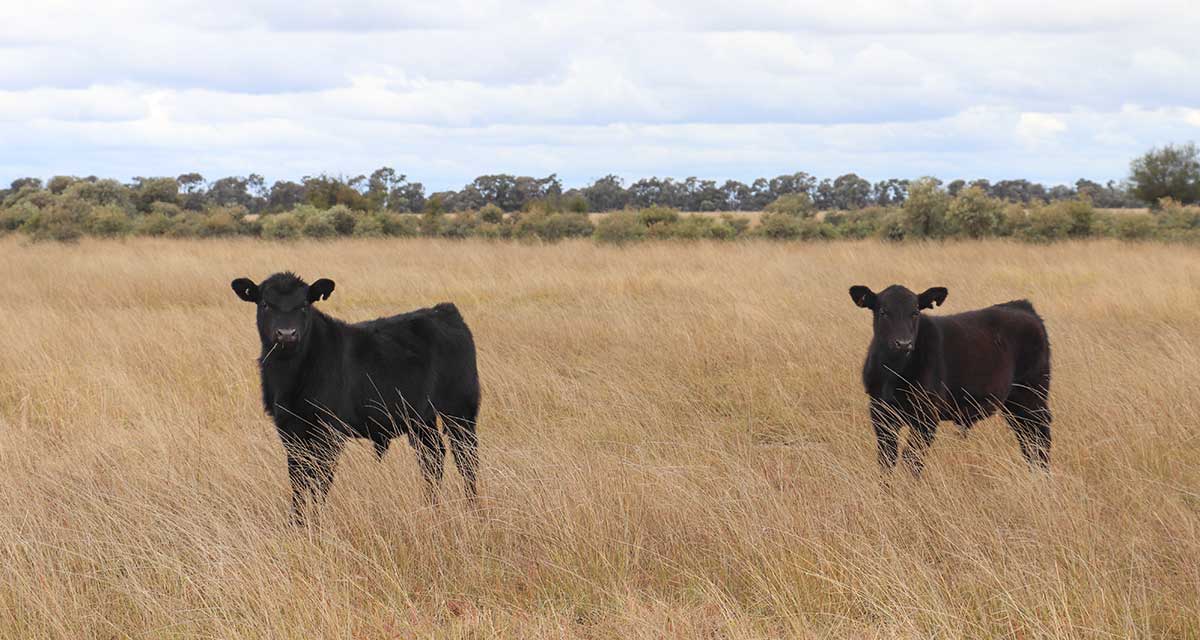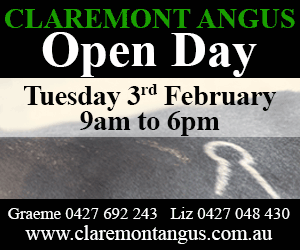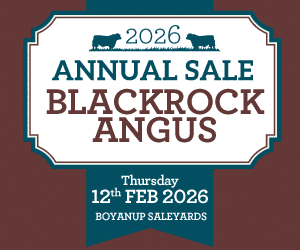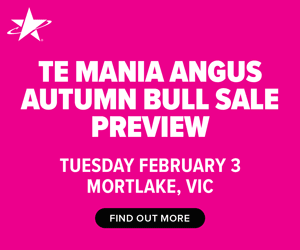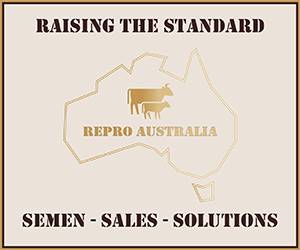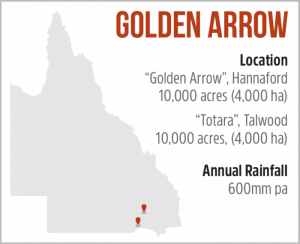 ‘Golden Arrow’, Hannaford has been in the Wells family since its development in 1932 and is currently owned and operated by David and Anna Wells, the third generation. David and Anna run a breeding operation, currently joining 600 pure bred Angus breeders and turn off roughly 250 weaner steers each year.
‘Golden Arrow’, Hannaford has been in the Wells family since its development in 1932 and is currently owned and operated by David and Anna Wells, the third generation. David and Anna run a breeding operation, currently joining 600 pure bred Angus breeders and turn off roughly 250 weaner steers each year.
Fertility is a key focus at Golden Arrow, with PTIC rates consistently between 94 and 96%. Joining is a three-month window from December 1st, and any female that returns empty at preg-testing is culled. Maiden heifers are first joined at 15 months of age – either to leased Wagyu bulls, with all F1 progeny supplied to a local feedlot operator as weaners, or to calving ease focussed Angus bulls.
“We like to value add to our heifer side of things by either joining them to Wagyu bulls for calving ease in our F1 program, or to low birth weight Angus Bulls and have the option to keep them or sell them as PTIC heifers” says David.
All pure-bred Angus progeny from the core breeding herd are weaned and the steers sold on AuctionsPlus at around 250kg liveweight while their heifer counterparts enter the breeding program.
David attributes part of the success of this program to the saleability of Angus.
“This year we are selling weaners for more money that we have ever have, but even back in 2018-2019, every time we went to sell our weaners on AuctionsPlus, we sold them every time, we have never had them passed in. We have always sold them at, or above, the market. They are just a saleable commodity, it doesn’t matter if you are in a dry season or a good season. There seems to be a concept that anything that is sold that’s 100% Angus, put extra cents and dollars on top of it.” he explains.
Approximately 80% of the bull herd on “Golden Arrow” are registered sires purchased externally, while the balance are bulls the Wells’ have bred themselves. When selecting a bull for purchase, David explained visual assessment is a must, but his initial step is to look at a bull’s EBVs. He prioritises genetic condition free bulls with low birth weight and high early growth (200 day weight), followed by carcase traits such as intramuscular fat.
When inducting a purchased bull, he allows for three months where, on delivery, the group of bulls purchased together are run with his small herd of five dairy cows.
“We keep them in the group of bulls they came with and put them in with our little herd of five dairy cows we use for paddy rearing just to get them used to their new surroundings. It keeps them quiet, lets them adjust before we add them to the bull herd, limits the fighting etc, for the three months before we join” says David.
Between joining seasons, the bull herd is run on a leucaena crop of around 150 acres to regain and maintain body condition.
Drought has played a significant role in shaping David and Anna’s business. Five years ago, the Wells’ were joining 1,000 breeders – 80% of which were Angus, the balance composites – over their two properties, ‘Totara’, Talwood and ‘Golden Arrow’, Hannaford. The successive dry years of 2017-2019 saw both properties completely destocked, the composite portion of the herd sold, and the remainder relocated to agistment near Windorah.
Now, with a good season behind them, ‘Totara’ leased, and 600 head of pure-bred Angus breeders left, David describes the restocking process at Golden Arrow as an opportunity to focus on their Angus genetics, particularly the selection of replacement heifers.
“What we want to achieve by coming back and focussing on just what we have got here at Golden Arrow is to do a lot more work with our replacement heifers” explains David.
“In the past we’ve chosen our replacement heifers at an age that hasn’t really given them all an opportunity to come back into the cycle. Because we have a three-month joining window, we were culling heifers for simply being three months younger. It interests me a lot, to have some extra tools to use when choosing those heifers and now that we have a season behind us, our program is to sell all the steers at weaning, we’re looking at doing more with those heifers by using HeiferSELECT with Angus Australia.” says David.
As a result of family succession, David and Anna inherited their pure bred Angus herd from David’s great uncle who started breeding Angus in the 60’s on a neighbouring property. When asked why they continued to use Angus, David lists fertility and saleability as the driving factors.
“I love the fertility of Angus, I haven’t had a lot to do with other breeds of cattle but from what I understand, we are just miles in front. Also, it’s being able to sell what you want to sell, when you want to sell it, and know you’re going to get the money for it.” says David.
“That was another big reason to go 100% Angus. When we had composites, every year we have had to 900 calves, we had 50-60 composite that stood out – they weren’t apart of the line, they weren’t as easy to sell, they took away our ability to say that everything else was 100% and it was costing us dollars” explains David.
David identified three limitations with running Angus at Golden Arrow; the lack of hybrid vigour in a pure bred herd, pink eye and buffalo fly.
“When we used to have a composite herd, our crossbred cattle would always be heavier, but the dollars you got for them were less than the 100% Angus, which offset the difference.” says David.
“Eyes are probably one of the biggest frustrations we face, it’s a cost. Some way to combat this would be fantastic” he says.
When it comes to buffalo fly, the Wells’ have experimented with a combination of drenches, ear tags and back rubbers to control them but are yet to find the perfect solution.
Overall, David and Anna’s strong focus on genetics aims to not only improve the fertility in their herd, but to gain insight into how what they are selecting for is performing in the supply chain.
“It’s not only about the heifer you are choosing, but it’s also to see how your genetics are performing. Despite that we have repeat clients, because we sell our steers on AuctionsPlus we don’t receive a lot of feedback in relation to how our cattle do in feedlots or elsewhere in the supply chain, we just don’t have that data. That’s where we’re trying to get to and to have HeiferSELECT, it’s an important tool that we’re hoping we can use.” says David.
Note: HeiferSELECT is a genomic selection tool, offered by Angus Australia, in partnership with Zoetis and Neogen. It is designed to inform the selection of Angus replacement females in commercial beef breeding operations that are 87.5% Angus breed content or greater. It provides genomic predictions for nine important maternal, growth and carcase traits. For more information, please click HERE.
Angus Australia acknowledges the funds provided by the Australian Government through the Meat & Livestock Australia Donor Company (MDC).
This resource was created as a result of a collaboration between Angus Australia and Meat & Livestock Australia Donor Company (MDC) (Project P.PSH.1063).

